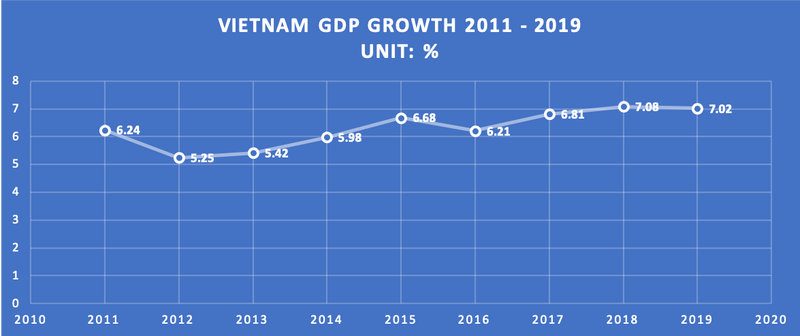Vietnam’s GDP growth in 2019 hits 7.02%: GSO
This is the second consecutive year that Vietnam’s economy expands over 7%, following a 10-year high GDP growth of 7.08% in 2018.
Vietnam’s GDP growth in 2019 achieved an impressive pace of 7.02%, far exceeding the target set by the National Assembly at 6.6 – 6.8%, the General Statistics Office (GSO) has announced.
| Data: GSO. Chart: Nguyen Tung. |
This is the second consecutive year that Vietnam’s economy expands over 7%, following a 10-year high GDP growth of 7.08% in 2018.
Specifically, GDP of the fourth quarter increased by 6.97% year-on-year, only lower than the growth rate in the third quarter of 7.48%, but higher than that the first two quarters at 6.82% and 6.73%, respectively.
In a context of global slowdown, not to mention the ongoing US – China trade war, a 7.02% expansion of the local economy indicated efficient state management and strong efforts of the government, stated the GSO.
In 2019, the sector of agriculture, forestry and fishery has increased by 2.01%, contributing 4.6% to the overall growth; the sector of industry and construction rose by 8.9%, contributing 50.4%; the service sector climbed by 7.3%, contributing 45%.
The driving force of the economy in 2019 continues to be the manufacturing and processing with an increase of 11.29%; followed by transportation with 9.12%; wholesale and retail with 8.82%, financial, banking and insurance services with 8.62%.
About the structure of the economy in 2019, the sector of agriculture, forestry and fishery made up 13.96%; the sector of industry and construction accounted for 34.49%; the service sector represented 41.64%; and product taxes less subsidies on production accounted for 9.91%.
In terms of GDP use this year, the final consumption rose by 7.23% against 2017; accumulated assets grew by 7.91%; trade balance of goods and services increased by 15.06%.
The contribution of total factor productivity (TFP), which is determined by how efficiently and intensely the inputs are utilized in production, to GDP in 2019 remained at 46.11%, higher than the 2016 - 2019 period of 44.46% and exceeding the average of 33.58% in 2011 - 2015.
The incremental capital-output ratio (ICOR) showed signs of improvements, going down from 6.42 in 2016 to 6.07 in 2019, averaging 6.14 in the 2016 – 2019 period and lower than 6.25 in 2011 – 2015.
ICOR explains the relationship between the level of investment made in the economy and the consequent increase in GDP. The higher the ICOR, the lower the productivity of capital or the marginal efficiency of capital.











